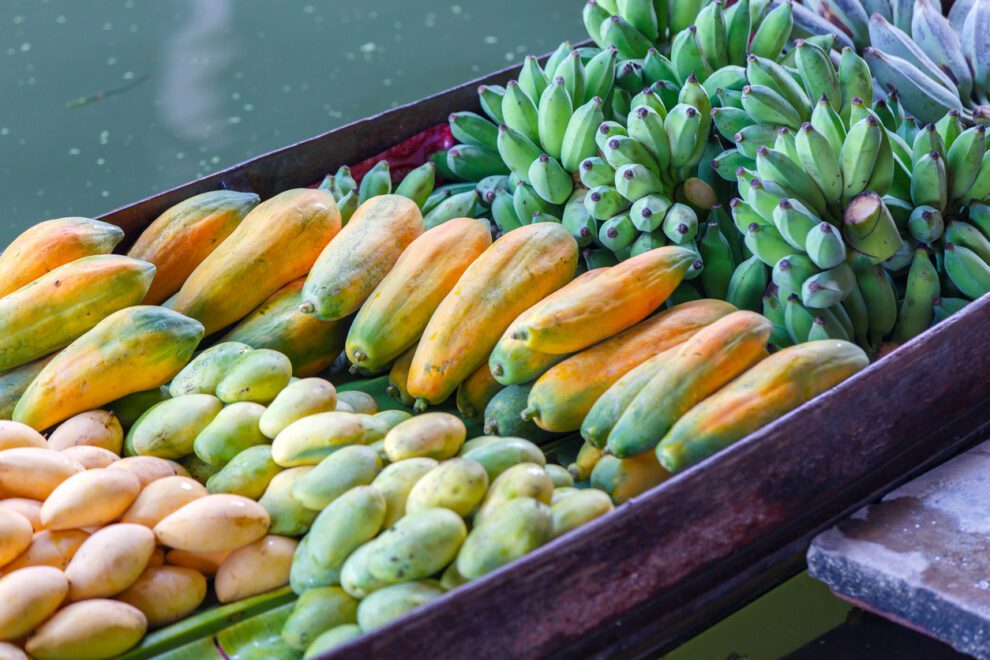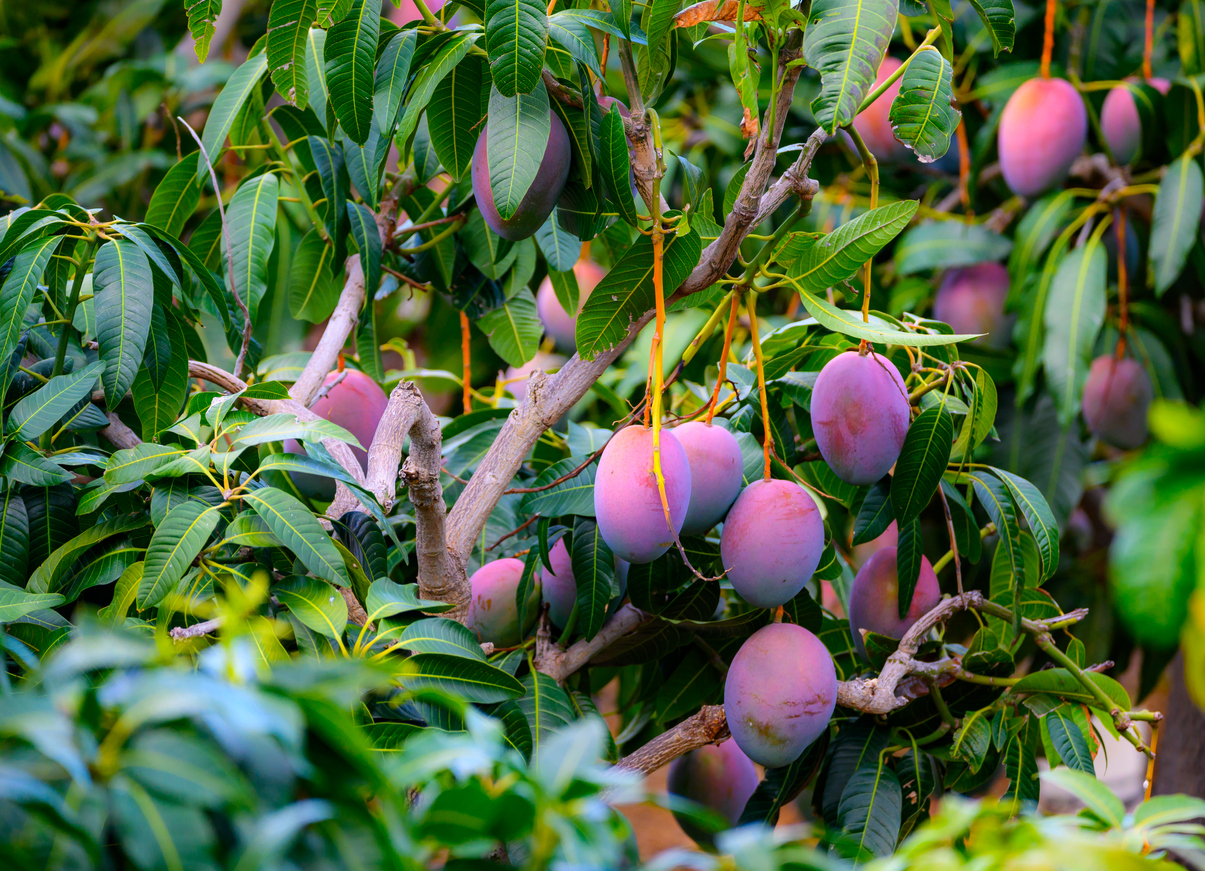Omega-3 fatty acids are essential fatty acids that your body doesn’t produce and thus need to be consumed. It’s naturally found in foods like fish, nuts, and seeds. However, one highly valuable source of omega-3s should gain more attention, specifically: tropical fruits!
Find a list of fruits and their ratios in this article, and discover why tropical fruits are the best source of omega-3s you can get!
The “omega ratio” in tropical fruits is optimal for humans
The omega-6 to omega-3 fatty acids ratio in most tropical fruits is in perfect line with recommendations for foods, around 1:1 and 2:1.
The perfect ratio (for humans) in those fruits might not be about where they are grown, but whether they have coevolved with the species as their consumer and seed disperser, or not! We come from a tropical frugivorous ancestry, and, thus, tropical fruits, are our “perfectly matching” foods. We have evolved and shaped the taste, color, and nutrition of tropical fruits throughout evolution (read more about the dispersal syndrome).
“Anthropological and epidemiological studies and studies at the molecular level indicate that human beings evolved on a diet with a ratio of omega-6 to omega-3 essential fatty acids (EFA) of approximately 1 whereas in Western diets the ratio is 15/1 to 16.7/1. “
Simopoulos, 2006
Most tropical fruits linger around the ratio of 1:1 and 2:1. Examples are bananas, papayas, açai berries, lychee, melons, and plantains. Passionfruit is an exception because it contains omega-6-rich seeds as part of the edible parts. Avocado also has a higher ratio, because they have not evolved as a food source for primates.
| Fruit | Omega 6:3 Ratio |
|---|---|
| Banana | 2:1 |
| Lychee | 1:1 |
| Açaí | 2:1 |
| Papaya | 1:4 |
| Melon | 1:1 |
| Mango | 2:1 |
| Pineapple | 1:1 |
| Plantain | 2:1 |
| Guava | 3:1 |
Temperate fruits tend to have a higher (not optimal) omega-6 to 3 ratio than tropical fruits! Some temperate fruits do not contain omega-3s at all. If you looking at temperate fruit to obtain your omega-3s, the darker-colored fruits have more healthy fatty acids. This includes most berries (which originally were food for mammals, not birds) and – the odd – cherries!
Why do many non-tropical fruits have a sub-optimal omega fatty acid profile? Most temperate fruits have evolved as food sources for birds, and thus, their nutritional profile differs from the ones that coevolved with mammals as consumers and seed dispersers (read more here). Those fruits were not edible for humans before cultivation and selective breeding!
| Fruit | Omega 6:3 Ratio |
|---|---|
| Apple | 5:1 |
| Apricot | 27:0 |
| Pear | 51:0 |
| Plum | 30:0 |
| Nectarine | 50:1 |
| Watermelon | 75:0 |
| Grapes | 5:1 |
| Raspberries | 2:1 |
| Cherries | 1:1 |
| Blackberry | 2:1 |
Top three fruits to get omega-3s
Tropical fruits and berries do not only contain the right ratio of omega-6:3, but many are also higher in content. The top three fruits to get good amounts of omega3s are:
- Açai berry: 95 mg omega-3s per cup
- Papaya: 68 mg omega-3s per 100g
- Blackberries: 135 mg omega-3s per cup
Do we need fish for omega-3s?
No, we don’t need to consume fish or fish oil for omega-3s. Tropical fruits are an excellent standalone source for our body. One thing that needs to be pointed out is, that humans are supposed to eat tropical fruits as a staple food, not a snack. Therefore, to get the usually recommended 1-1.5 grams of omega-3s from tropical fruits, consider increasing your intake of tropical fruits! You won’t be disappointed with the diverse health effects that come along with this dietary change!
Omega-3s are a family of polyunsaturated fats essential for a healthy, well-functioning body. There are three main types of omega-3s.
- Alpha-linolenic acid (ALA)
- Eicosatetraenoic acid (EPA)
- Docosahexaenoic acid (DHA)
ALA omega-3s are primarily found in plant foods, like nuts, vegetables, and fruits, and seed oils (which are otherwise not recommendable). EPA and DHA are more prominently found in fish, a fact that provides them their nickname, marine omega-3s. However, you don’t need to eat the omega-3 from eating fish or taking fish oil supplements because the body can obtain EPA and DHA from ALA. Tropical fruits are a sufficient and healthy source of omega-3s. Especially when you have a hype-inflammatory diet, the omega3s from vegetable sources are enough!
What about the low conversion of ALA to EPA and DHA? Nutritional deficiencies, like iron, magnesium, zinc, or B vitamins decrease the conversion rate (C. Ferrer, 2013), which is why adopting a natural, nutrient diet – our species-specific diet rich in tropical fruits – is key to getting the full benefits of omega3s!
Biological function and benefits of Omega-3s
Our body is an interconnected web of signals that need essential nutrients to communicate and function properly. Omega-3 is one of those nutrients; responsible for cell signaling, anti-inflammatory processes, blood pressure, glucose tolerance, and so much more. Omega-3 is a powerhouse nutrient essential for a healthy diet and body (Gammone, 2019).
Among many benefits, omega-3s can help lower triglycerides, reduce blood clotting and offer some protection against heart disease and stroke. Omega-3s are also anti-inflammatory, which is important in the age of inflammatory conditions!
Since the brain is a fatty tissue, omega3s affect brain health. Omega 3 is a type of fat needed for brain function, thus, a deficiency could lead to mental health issues. Omega-3 help prevent memory loss in older adults (Yurko-Mauro, 2015) and has even been shown to help with ADHD.
Overall, the significant benefits of omega-3 include properties such as anti-inflammatory, and beneficial for brain function, and cardiovascular health.
Conclusion
Omega3 is an essential fatty acid that your body does not produce and thus needs to be consumed. It is naturally found in foods like fish and fruits, specifically tropical fruits. As tropical frugivores, our natural staple foods – high-quality tropical fruits – provide us with the bulk of nutrients we have evolved to obtain from our diet, including the essential omega 3s. Eating tropical fruit like mangoes, papayas, and açai bowls is the best way to get your daily dose of omega-3 in the optimal ratio!
References
- Simopoulos, A.P. (2010a) ‘The omega-6/omega-3 fatty acid ratio: Health implications’, Oléagineux, Corps gras, Lipides, 17(5), pp. 267–275. doi:10.1051/ocl.2010.0325.
- Simopoulos, A.P. (2006) ‘Evolutionary aspects of diet, the omega-6/omega-3 ratio and genetic variation: Nutritional implications for chronic diseases’, Biomedicine & Pharmacotherapy, 60(9), pp. 502–507. doi:10.1016/j.biopha.2006.07.080.
- Abazar (no date) Omega-3 and omega-6 fatty acids in fruits, CAASN. Available at: https://caasn.com/omega-3-and-omega-6-fatty-acids-in-fruits.html (Accessed: 10 August 2023).
- Omega-3 fatty acids (no date) NIH Office of Dietary Supplements. Available at: https://ods.od.nih.gov/factsheets/Omega3FattyAcids-HealthProfessional/ (Accessed: 10 August 2023).
- Watson, R. ross and Preedy, V.R. (2013) Bioactive food as dietary interventions for liver and gastrointestinal disease. San Diego: Academic Press.
- Gammone, M. et al. (2018) ‘Omega-3 polyunsaturated fatty acids: Benefits and endpoints in Sport’, Nutrients, 11(1), p. 46. doi:10.3390/nu11010046. Bornfeldt, K.E. (2021) ‘Triglyceride lowering by omega-3 fatty acids: A mechanism mediated by N-acyl taurines’, Journal of Clinical Investigation, 131(6). doi:10.1172/jci147558.
- Bornfeldt, K.E. (2021) ‘Triglyceride lowering by omega-3 fatty acids: A mechanism mediated by N-acyl taurines’, Journal of Clinical Investigation, 131(6). doi:10.1172/jci147558.
- DiNicolantonio, J.J. and OKeefe, J. (2019) ‘Importance of maintaining a low omega-6/omega-3 ratio for reducing platelet aggregation, coagulation and thrombosis’, Open Heart, 6(1). doi:10.1136/openhrt-2019-001011.
- Yurko-Mauro, K., Alexander, D.D. and Van Elswyk, M.E. (2015) ‘Docosahexaenoic acid and adult memory: A systematic review and meta-analysis’, PLOS ONE, 10(3). doi:10.1371/journal.pone.0120391.
- Kiliaan, A. and Königs, A. (2016) ‘Critical appraisal of omega-3 fatty acids in attention-deficit/hyperactivity disorder treatment’, Neuropsychiatric Disease and Treatment, Volume 12, pp. 1869–1882. doi:10.2147/ndt.s68652.




Add Comment